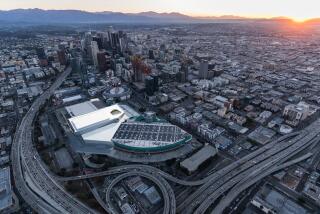Video Eye Watches Convention Center Work
- Share via
The videotapes that Fluor Constructors’ camera churns out each work day at the convention center construction site in San Diego won’t ever challenge the popularity of Jane Fonda’s exercise tapes.
For starters, the videos are downright boring. The plot, although complex, is obvious: A big hole in the ground is gradually being turned into a $110-million, multilevel exhibition and convention center.
But Fluor’s project manager for the job, Billy G. Crockett, didn’t install the cameras to win cinematography awards. Rather, Fluor Constructors, which manages the convention center construction site for the San Diego Port District, uses the videos to augment written records of the complicated building project.
The videos provide visual proof that can help settle billing disputes--and, down the line, lawsuits--among subcontractors at the convention center that sits hard by San Diego Bay.
“We can get an overall perspective of the job by watching the tapes,” Crockett said. “We have a visual record, since the (camera) also shows the exact time and day that the picture was taken.”
The camera, along with videotape and assorted electronic components, cost several thousand dollars. But the Port District, which owns the convention center, expects to recoup that cost before the project is completed in late 1989, Crockett said.
From a technical standpoint, the videotapes are incomplete because the camera that tracks progress clicks on only eight times a minute. And visual quality is sometimes poor because the wide-angle lens follows the action from a small room on the 26th floor of the adjacent Marriott Hotel.
Crockett learned to use cameras to capture construction-site action when he was with the Navy. “The Navy used it for quite a few things, including the gathering of intelligence,” Crockett said. “They flopped it over into construction because it’s a good tool” to help iron out differences when contract disputes arise.
The Navy used an older, 8-millimeter camera to provide a film log of work at its new, $293-million hospital in Balboa Park. The Navy jockeyed that camera among six locations in order to capture an overview of work at the 1.2-million-square-foot hospital that is one of the nation’s largest medical complexes.
“It gives us documentation over the life of the project,” said Cmdr. Edward Morris, the Navy’s resident officer in charge of construction at the massive hospital.
The Navy uses the films, which are developed and stored in government archives, to settle disputes with contractors and subcontractors. “There are always questions that come up later,” Morris said.
Contractors involved in disputes with subcontractors have used the Freedom of Information Act to gain access to the films, Morris said.
During construction at the Balboa Park hospital, for example, the prime contractor and a subcontractor viewed the films to settle a dispute involving a shipment of structural steel.
Elsewhere in the country, construction companies also have used the films to recreate events leading up to accidents. A film record of an accident involving scaffolding, for example, could determine if the scaffolding were faulty or if the injured worker was using proper safety procedures.
Crockett is using the convention center videos to monitor critical construction schedules that must be met if the project is to be completed on time. Inspectors on the ground typically chronicle progress, but “ . . . you can’t get the overview unless you’re 26 stories up,” another Fluor executive said. “It really helps you get the whole picture.”
Fluor regularly focuses the camera on trouble spots. Recently, the camera was shifted slightly to tape a drilling rig after a subcontractor reported a problem that could delay construction.
Contractors also review videos of completed projects to more efficiently schedule work at a complicated construction site. The Navy has used films to improve scheduling of subcontractors, Morris said.
But videos or films, no matter how complete, are not enough to replace more traditional reporting methods, Morris said. “The Navy insists on documenting everything, be it phone calls, correspondence, whatever,” Morris said. “This is just one more arm of that documentation.”
More to Read
Inside the business of entertainment
The Wide Shot brings you news, analysis and insights on everything from streaming wars to production — and what it all means for the future.
You may occasionally receive promotional content from the Los Angeles Times.










